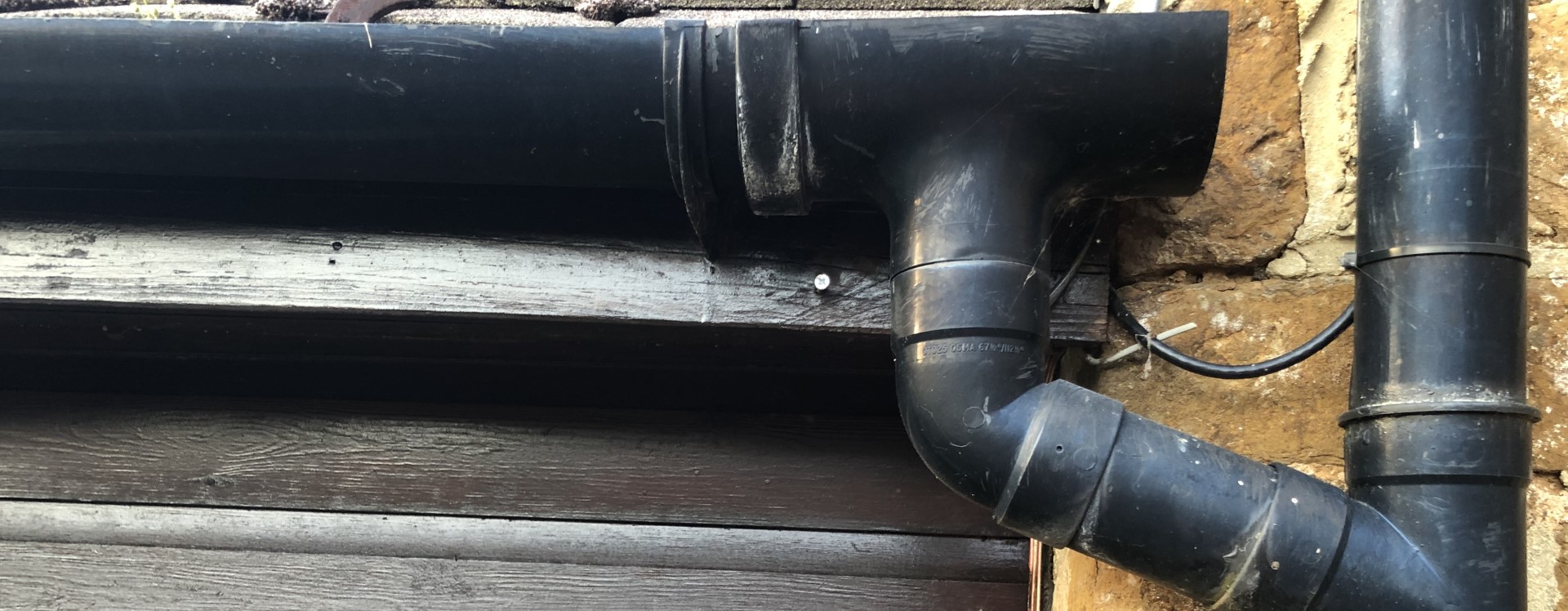If your home has a problem with damp or water ingress, you probably already have an inkling that something’s up. In the second edition in our series on home maintenance projects for lockdown, we’ve set out checklists for reviewing your home’s drainage and roof systems and for checking if you have an issue with damp.
Lockdown Drainage, Roof & Damp Checklists
Check your drainage system
Drainage issues can cause problems ranging from cosmetic staining on exterior walls, to damp and even structural damage to foundations. Some investigations require specialist equipment such as pen cameras to look underground, but many checks can be done yourself at home.
When the weather’s dry
– Check outside walls for peeling paint, stains and streaks. Vertical stains going down the wall could be a sign that gutters have been leaking.
– If you have a cellar, check the walls for horizontal stains going around the perimeter. In the absence of previous flooding, this could suggest that the water table around the home is high or fluctuating, which can lead to water leaking into your home. If the water table is a problem for you, installing a sump pump will keep the water to an acceptable level.
– If you still suspect you have issues with drainage, check the inside of your roof for mildew. If you have too much moisture in your home, warm air will be carrying up to the attic, where it will condense and allow mildew to grow.
– Review the slope of the ground around your house. The ground should be gently sloping away from your walls. If it isn’t, water will be directed towards the bottom of your property and could get trapped there.
When it’s raining
– Next time it rains, go outside and have a look at your gutters. If they’re overflowing, they are likely to be blocked by leaves or other debris. If in doubt, clean out your gutters to make sure water can flow freely. If the problem returns quickly, despite cleaning, you might need bigger gutters and/or you may need to adjust their slope.
– Take a look at your drains. Is water flowing freely? Is anything blocking them? Keeping drains clear is crucial for stopping a build-up of standing water, which in turn can leak through the external walls into your home, causing rising damp.
– Look at where downspouts are directing water. If it’s running down your walls, there’s a good chance that some of it will end up getting absorbed. You can fix the problem by simply extending the downspouts so that the water runs out a few feet away from the walls of your home. Alternatively, you can arrange to dig drainage ditches that will channel water away from your property.
– After a decent shower of rain, look at your garden and driveway – are there any puddles that stick around once the neighbours’ gardens are dry? This could suggest an issue with drainage and can make the area unusable. Fix it by booking in a contractor to install ground drainage.
Check your roof
Roofs are clearly vital to any property! Knowing whether you have any issues can be tricky, and if you do suspect a problem it might be worth considering a survey. However, there are some warning signs that you can be on the lookout for and it’s worth the effort; spotting issues early can mean that roofing repairs are possible. However, if the damages are extensive, a roof replacement may be more ideal.
Inside the roof
– Look at the appearance of the inside of the roof. Is it uniform, or are there any dark streaks? If you see the latter, you might have mould or damp stains, suggesting that water is seeping through from outside.
– Is the surface smooth, or can you see sagging? If you do see curving of the roof material this could indicate that there is a structural problem with the roof.
– You probably don’t need us to tell you this, but if you see water coming through the roof, or if you can see daylight through it, you have holes in your roof! Get these repaired as soon as possible to prevent further damage.
Outside the roof
*Only examine the outside of your roof if it is safe to do so – otherwise call a professional to carry out a roof inspection for you.
– Are the tiles in good condition? Get any damaged tiles replaced to avoid leaks and structural damage.
– Do you have algae, moss, mould or even plants growing on your roof? This can cause premature deterioration of the tiles.
– If you have a flat roof, check for puddles of water after rainfall. This suggests that drainage from the roof is not working properly. The standing water can damage the roof if the problem is not fixed, so arrange for repairs as soon as possible.
Does your property have damp?
Despite being a common problem, damp is worrying for both homeowners and tenants. Not only does it cause cosmetic damage, it can make rooms very unpleasant to live in and can even be hazardous to health if it results in excessive mould growth.
– Put your hand against the walls of your rooms. If they feel damp, or even unusually cold, you might have a problem.
– Similarly, flaking paint, peeling wallpaper, brown staining, excessive condensation on windows and a musty, damp smell are all signs of damp.
– One of the main issues associated with damp is that it can promote the growth of mould. Check for mould by looking for black or grey spots or patches on timber, walls (whether they’re painted or wallpapered), windows (even PVC frames and silicone seals), soft furnishings and curtains.
– If you do think you have damp, carry out the drainage and roof checks above to establish whether you need to carry out any preventive works.
– Damp can simply be caused by excess moisture production during household tasks such as tumble-drying clothes, boiling water and having hot showers. This moisture condenses on cold surfaces, causing damp and encouraging mould growth. To avoid damp problems, try and keep rooms well-ventilated, whether that’s by opening windows, installing extractor fans or using dehumidifiers. Keeping your home at a constant, fairly warm temperature will also help reduce condensation.
– If you have found mould around your house, and you have already followed the steps above to remove the cause of the damp, it can be removed. The first step is to check that the affected area has dried out. You can then apply a mouldicide or fungicide treatment (available at most DIY stores) to remove the mould. If the room is likely to have high levels of moisture in the future, such as might be the case for bathrooms or kitchens, consider redecorating with moisture-resistant paint or wallpaper.











